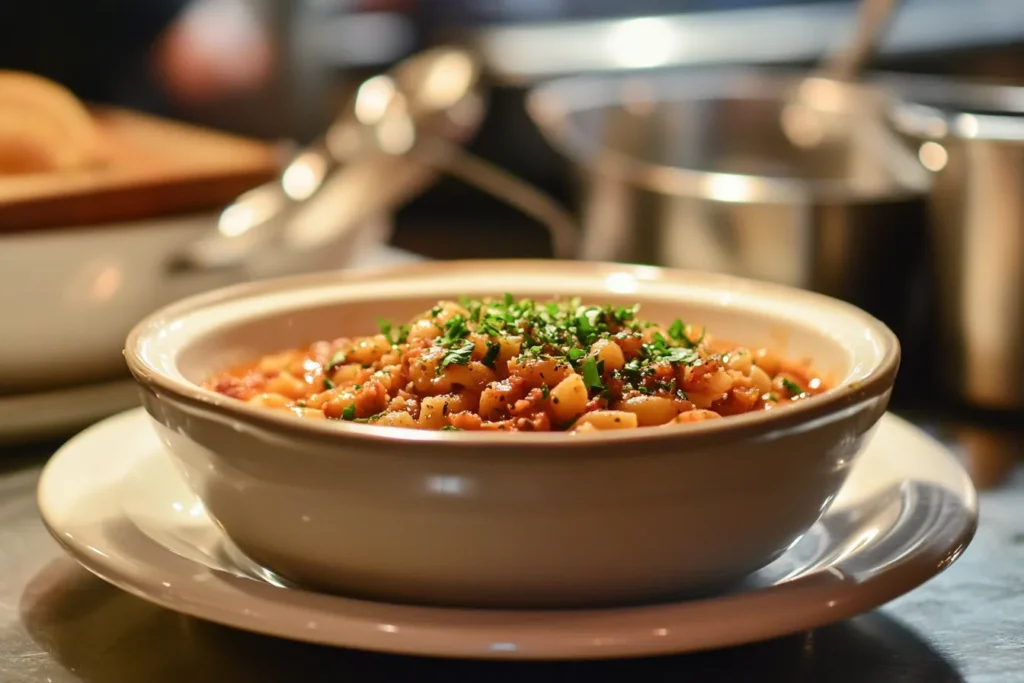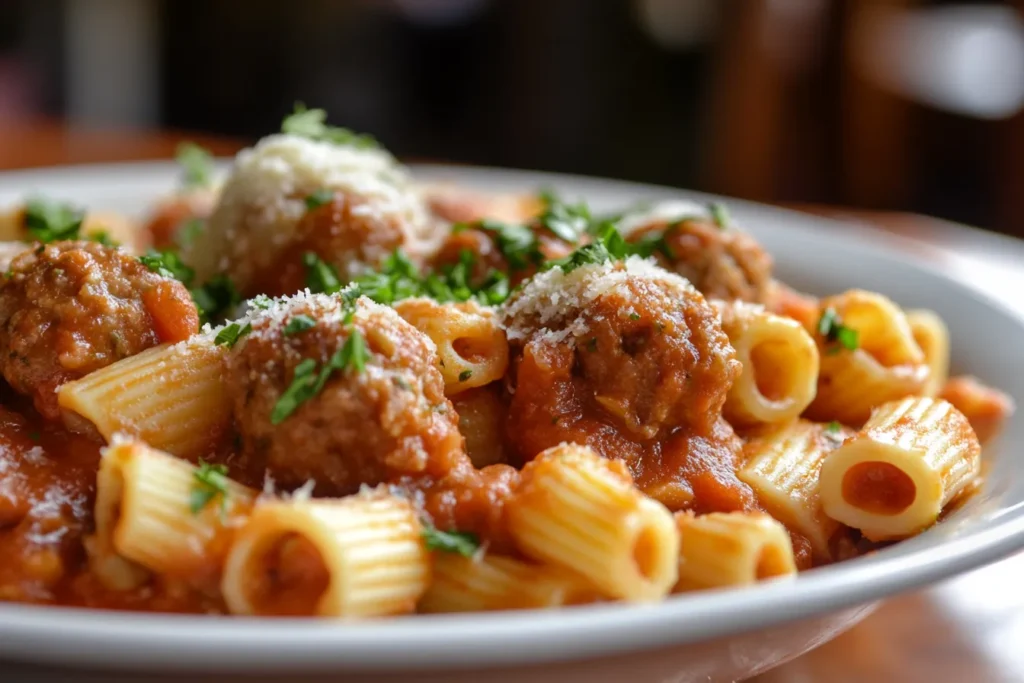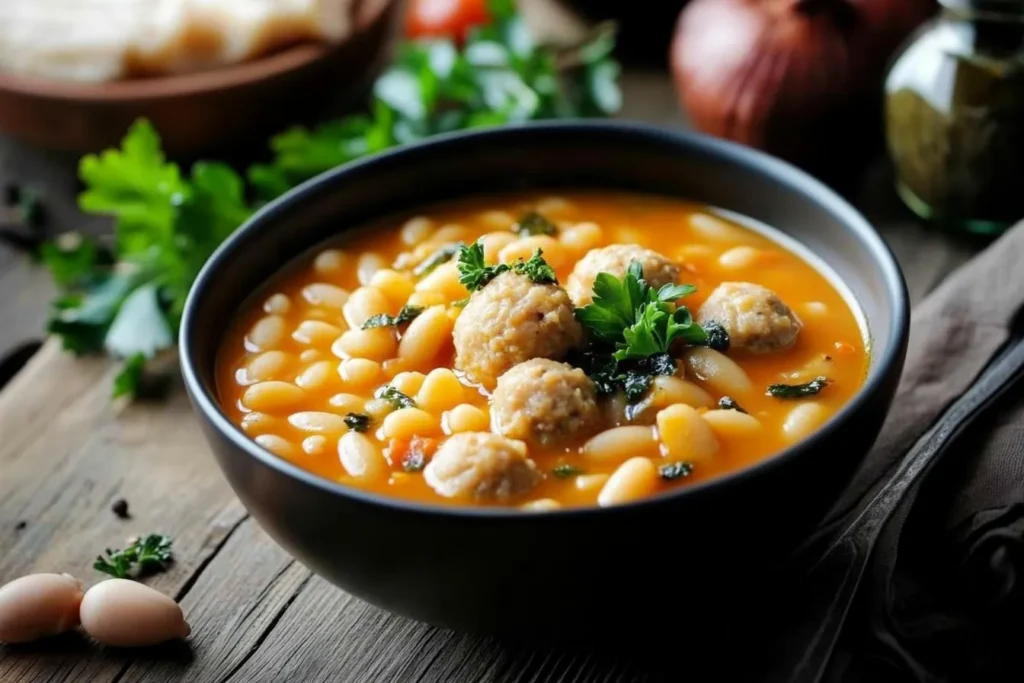Have you ever found yourself craving Olive Garden’s famous Pasta e Fagioli but didn’t feel like heading out or waiting for takeout? You’re not alone! This hearty, comforting soup is a fan favorite, and for good reason—it’s loaded with tender pasta, savory ground beef, hearty beans, and a perfectly seasoned broth. But what if I told you that you can make this restaurant classic right at home? I’ve been there too, wishing I could enjoy my favorite dish without leaving my kitchen. That’s why I’m excited to share this easy Olive Garden Pasta e Fagioli recipe so you can recreate all the deliciousness at home, anytime you want. Let’s get cooking!
List Of Contents
Olive Garden Pasta e Fagioli Recipe: A Classic Italian-American Delight
When you think of comfort food, Olive Garden’s Pasta e Fagioli stands out as an iconic dish that blends simplicity with bold flavors. This hearty Italian-American soup combines tender pasta, beans, vegetables, and protein in a savory broth. Whether you’re a fan of Olive Garden’s take on this classic recipe or are curious about its appeal, this guide will delve into the background, benefits, and key ingredients to help you recreate it at home. Check out more recipes here.

What is Pasta e Fagioli?
Pasta e Fagioli, which translates to “pasta and beans,” is a traditional Italian dish rooted in peasant cooking. It originated as a humble meal, using inexpensive ingredients like dried beans and pasta, making it both affordable and satisfying. While traditional recipes often rely on olive oil, garlic, and herbs, American adaptations, like Olive Garden’s version, add hearty proteins and a touch of spice for a richer flavor profile. Check out more recipes here.
The Origins of Olive Garden’s Version of Pasta e Fagioli
Olive Garden’s Pasta e Fagioli reflects Italian-American cuisine’s evolution—bringing the rustic charm of Italian cooking to the American dining table. The recipe incorporates beef, a medley of vegetables, and a tomato-based broth, offering a modern twist on the traditional recipe.
With its robust flavor and approachable ingredients, this soup has become a fan favorite. Olive Garden’s recipe stands out for its balance of flavors, texture variety, and versatility, appealing to a wide range of palates. Check out more recipes here.
Why This Soup is a Crowd Favorite
There’s a reason this dish consistently ranks among Olive Garden’s most popular menu items. Here’s why people love it:
- Hearty and Filling: The combination of beans, pasta, and protein makes it a complete meal.
- Versatile: Easily adaptable to vegetarian or gluten-free diets.
- Flavorful: A perfect balance of savory, herby, and slightly tangy notes.
- Comforting: Ideal for chilly days or when you crave something warm and nourishing.
Benefits of Making Pasta e Fagioli at Home
Cost Savings: A Budget-Friendly Meal
One of the most compelling reasons to make Pasta e Fagioli at home is the potential for cost savings. Many of the essential ingredients—like beans, pasta, and canned tomatoes—are pantry staples and incredibly affordable. With one pot of this soup, you can feed a family or meal prep for the week without breaking the bank.
Customization: Tailoring the Recipe to Your Taste
Cooking at home allows you to tailor the dish to your preferences:
- Adjust the protein: Swap beef for Italian sausage, chicken, or a plant-based alternative.
- Add extra vegetables: Include zucchini, kale, or mushrooms for added nutrients.
- Control the spice level: Amp up the heat with red pepper flakes or keep it mild for younger palates.
Health Benefits of Ingredients in Pasta e Fagioli
This soup isn’t just delicious—it’s packed with nutritional value:
- Beans: High in protein and fiber, helping you stay full longer.
- Vegetables: Loaded with vitamins and antioxidants.
- Tomatoes: Rich in lycopene, a compound linked to reduced inflammation and heart health.
- Whole-grain pasta (optional): Boosts the dish’s fiber and nutrient content.
Essential Ingredients Overview
Traditional Ingredients in Pasta e Fagioli
At its core, Pasta e Fagioli includes:
- Beans: Cannellini or kidney beans are most common.
- Use small pasta shapes such as ditalini or elbow macaroni for the best results.
- The soup’s aromatic base consists of onion, garlic, carrots, and celery.
- Herbs and Spices: Oregano, basil, and bay leaves add depth and complexity to the flavor.
- Broth: A mix of chicken or vegetable stock and tomato sauce creates a rich, flavorful base.
Olive Garden’s Signature Touch to the Recipe
What sets Olive Garden’s version apart? Key additions like:
- Ground beef: Adds a savory richness to the soup.
- Herb seasoning blend: Includes parsley, thyme, and Italian seasoning for enhanced flavor.
- A tomato-rich base results in a broth that is slightly thicker and tangier than traditional versions.
How to Make Olive Garden Pasta e Fagioli at Home
Recreating the popular Pasta e Fagioli from Olive Garden at home is easier than it seems. With a few readily available ingredients and straightforward steps, you can bring the restaurant experience to your kitchen.
Ingredient List

Beans: Choosing the Right Variety
Beans are the centerpiece of this dish, providing both creaminess and protein. Olive Garden’s version traditionally uses a mix of cannellini beans and red kidney beans for variety in texture and flavor. Cannellini beans offer a buttery, soft texture, while red kidney beans retain their shape, enhancing both the appearance and texture of the dish.
Pasta: Ideal Shapes for Authentic Pasta e Fagioli
The key to choosing the right pasta is selecting a shape that complements the beans without overpowering the dish. Traditional options include:
- Ditalini: A small tube-shaped pasta that perfectly absorbs the soup’s flavors.
- Elbow macaroni: An accessible alternative.
- Orzo: If you prefer a lighter texture.
Cooking tip: Cook the pasta separately to avoid overcooking it in the soup, and add it just before serving.
Vegetables and Aromatics: Building the Flavor Base
The rich and aromatic flavor of Pasta e Fagioli comes from a mirepoix—a blend of onions, carrots, and celery sautéed in olive oil. Garlic, another essential ingredient, adds depth. The quality of these vegetables can make or break the soup, so opt for fresh, firm produce.
Additional vegetables to consider:
- Zucchini: For added texture.
- Spinach is added at the end to provide a nutritional boost.
Protein Options: Beef, Sausage, or Vegetarian Alternatives
The Olive Garden original features ground beef, but you can experiment with other options:
- Italian sausage: Adds a spicier, more robust flavor.
- Ground turkey: A leaner option.
- Plant-based crumbles: Perfect for vegetarian adaptations.
To make a vegetarian version, skip the meat and emphasize flavor by enhancing the vegetables and seasonings.
Kitchen Tools You’ll Need
Cooking Pots and Utensils for Soup Preparation
- Large soup pot: Ideal for preparing a one-pot meal.
- Cutting board and sharp knife: For chopping vegetables.
- Wooden spoon or spatula: For stirring the ingredients evenly.
- Ladle: Essential for serving.
Optional Gadgets for Speed and Efficiency
- Food processor: Speeds up chopping for the mirepoix.
- Immersion blender: If you prefer a creamier soup, blend a small portion of the beans before adding them to the pot.
Step-by-Step Cooking Instructions
Preparing the Vegetables and Protein
- Chop the mirepoix: Dice the onions, carrots, and celery into small, uniform pieces.
- Mince the garlic: Freshly minced garlic releases more flavor than pre-minced varieties.
- Brown the protein: In a large soup pot, cook the ground beef (or your chosen protein) over medium heat until browned. Drain any excess fat and set aside.
Cooking the Soup Base and Adding Flavors
- Sauté the vegetables: In the same pot, heat a tablespoon of olive oil. Sauté the onions, carrots, and celery until they soften, approximately 5 minutes.
- Incorporate the minced garlic and cook for another minute, stirring constantly.
- Incorporate the broth and tomatoes:
- Pour in the chicken or vegetable broth.
- Add canned crushed tomatoes or tomato sauce.
- Stir in the dried herbs: oregano, basil, and a bay leaf.
Simmering the Soup to Perfection
- Add the beans: Rinse and drain the cannellini and kidney beans, then add them to the pot.
- Return the protein: Stir in the browned ground beef or your chosen alternative.
- Simmer: Reduce the heat and let the soup simmer gently for 20–30 minutes, allowing the flavors to meld.
Adding Pasta and Final Touches
- Cook the pasta separately: Boil the pasta until just al dente, then drain and rinse with cold water to stop the cooking process.
- Combine pasta and soup: Just before serving, stir the pasta into the soup to prevent it from becoming overly soft.
- Finish with garnishes:
- Sprinkle with freshly grated Parmesan cheese.
- Add a drizzle of extra virgin olive oil or fresh parsley for a burst of flavor.
Perfecting and Serving Pasta e Fagioli
Creating the perfect Pasta e Fagioli goes beyond following a recipe. It’s about understanding the nuances of texture, flavor, and presentation. This section provides expert tips, creative variations, and serving suggestions to elevate your dish to restaurant-quality.
Tips for the Best Homemade Pasta e Fagioli

Achieving the Ideal Consistency
Consistency is key to a satisfying Pasta e Fagioli. The soup should be hearty, not watery, with a balance of liquid and solids.
- For a thicker broth: Mash a small portion of the beans and stir them back into the soup.
- For a soupier texture: Add extra broth or water during the simmering stage.
- Avoid overcooking the pasta: Always cook the pasta separately to ensure it retains its texture.
Balancing Flavors: Herbs, Spices, and Seasonings
The right balance of seasoning transforms a good soup into a great one. Here are a few tips:
- Use fresh herbs whenever possible. While dried herbs work well, fresh parsley or basil added at the end enhances the flavor.
- Don’t skip the bay leaf: It adds a subtle depth that ties the flavors together.
- Season gradually by adding salt and pepper in layers, tasting along the way.
Common Mistakes and How to Avoid Them
- Overcooking the pasta: Adding pasta too early can make it mushy. Keep it separate until just before serving.
- Under-seasoning: Taste the soup frequently and adjust salt, pepper, or herbs as needed.
- Skipping aromatics: Onion, garlic, and celery are essential for building a rich flavor base.
Recipe Variations
Vegetarian and Vegan Versions
To create a vegetarian version, leave out the meat and substitute with vegetable broth. To make it vegan:
- To create a vegan version, replace Parmesan cheese with nutritional yeast or a vegan Parmesan alternative.
- Add extra beans or tofu for protein.
Gluten-Free Adaptations
Transform this dish into a gluten-free option by substituting traditional pasta with gluten-free alternatives like:
- Lentil or chickpea pasta.
- Gluten-free elbow macaroni or ditalini.
Regional Twists on Pasta e Fagioli
While Olive Garden’s recipe is a modern adaptation, traditional Italian versions vary by region:
- Tuscan Style: Features white beans and rosemary, often with a thicker consistency.
- Southern Italian Variations: Incorporate spicy sausage and extra tomatoes for a robust and bold flavor profile.
- Northern Italian Adaptations: Include pancetta or prosciutto for a smoky touch.
Pairing and Serving Suggestions
Best Breads to Serve with Pasta e Fagioli
No bowl of Pasta e Fagioli is complete without a side of bread. Consider these options:
- Crusty Italian bread: Perfect for dipping.
- Garlic bread: Adds a flavorful, buttery complement.
- Focaccia: For a soft, herby pairing.
Wines and Beverages that Complement the Dish
Pairing Pasta e Fagioli with the right drink enhances the dining experience:
- Red wine: A medium-bodied Chianti or Sangiovese complements the tomato-based broth.
- White wine: A crisp Pinot Grigio balances the richness of the soup.
- Non-alcoholic options: Sparkling water with a slice of lemon or herbal tea pairs well.
How to Store and Reheat Leftovers
Pasta e Fagioli is an excellent dish for meal prepping or saving leftovers:
- Refrigeration: Keep in an airtight container and store for up to 4 days.
- Freezing: Freeze the soup (without pasta) in individual portions for up to 3 months. Add fresh pasta when reheating.
- Reheating: Gently warm on the stovetop over low heat, stirring occasionally.If the soup has thickened too much, add a splash of water or broth to adjust the consistency.
FAQs
1. What does “Pasta e Fagioli” mean?
It translates to “pasta and beans” in Italian, highlighting the two main ingredients.
2.Is it possible to substitute dried beans with canned ones?
Yes, canned beans are a convenient option. Simply rinse and drain the canned beans before incorporating them into the soup.
3. What type of pasta works best for this dish?
Ditalini is the most traditional choice, but elbow macaroni or orzo also work well.
4. How do I make the soup less salty?
Use low-sodium broth and canned beans, and season gradually to control the salt level.
5. Can I add other vegetables?
Absolutely! Zucchini, spinach, or even peas make great additions.
6. Is this dish traditionally vegetarian?
Yes, the original Italian version is often vegetarian, but modern adaptations include meat for added flavor
7. How do I make this dish spicy?
Add a pinch of red pepper flakes or use spicy Italian sausage.
8. What’s the best way to thicken the broth?
Crush some of the beans or puree a portion of the soup.
9. How do I prevent leftovers from becoming mushy?
Store the pasta separately and add it to the soup just before reheating.
10. Can I cook this in a slow cooker?
Yes! Combine all ingredients except the pasta and cook on low for 6–8 hours. Add cooked pasta at the end.
